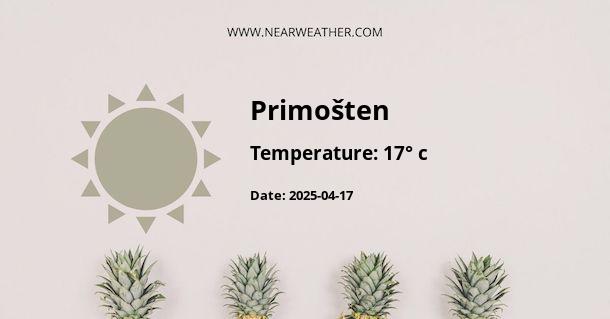Climate and Weather in Primošten, Croatia
Primošten is a small town situated in the heart of the Adriatic coast of Croatia. Famed for its picturesque beaches and historical charm, Primošten also boasts a Mediterranean climate that appeals to a wide range of visitors, from sun-seeking vacationers to viticulture enthusiasts. In examining the unique weather patterns of Primošten, one will find a typical coastal Mediterranean climate with hot, dry summers and mild, wet winters. The climate greatly influences the local way of life, including the cultivation of olives, grapes, and the production of renowned Croatian wines.
Temperature Overview
The temperature in Primošten varies seasonally, with the warmest months being July and August and the coolest period during January and February. Below is an overview of the average high and low temperatures throughout the year:
- January: High 10°C (50°F), Low 2°C (35.6°F)
- February: High 11°C (51.8°F), Low 3°C (37.4°F)
- March: High 14°C (57.2°F), Low 6°C (42.8°F)
- April: High 18°C (64.4°F), Low 10°C (50°F)
- May: High 23°C (73.4°F), Low 14°C (57.2°F)
- June: High 27°C (80.6°F), Low 18°C (64.4°F)
- July: High 30°C (86°F), Low 21°C (69.8°F)
- August: High 30°C (86°F), Low 21°C (69.8°F)
- September: High 25°C (77°F), Low 16°C (60.8°F)
- October: High 21°C (69.8°F), Low 12°C (53.6°F)
- November: High 16°C (60.8°F), Low 8°C (46.4°F)
- December: High 12°C (53.6°F), Low 4°C (39.2°F)
Precipitation Patterns
Rainfall in Primošten is characteristic of Mediterranean climates, where the wet season occurs from late autumn through to early spring. Summers tend to be quite dry.
The highest amount of rainfall is typically seen in November, with precipitation averages around 113.3 mm (4.46 inches). In contrast, the dry summer months may only have around 30 mm (1.18 inches) of rain in total.
A better understanding of the annual precipitation can be gleaned from the following data:
- January: 89.1 mm (3.51 inches)
- February: 77.4 mm (3.05 inches)
- March: 73.5 mm (2.89 inches)
- April: 64.3 mm (2.53 inches)
- May: 57.8 mm (2.28 inches)
- June: 50.2 mm (1.98 inches)
- July: 37.1 mm (1.46 inches)
- August: 44.0 mm (1.73 inches)
- September: 85.0 mm (3.35 inches)
- October: 97.5 mm (3.84 inches)
- November: 113.3 mm (4.46 inches)
- December: 104.1 mm (4.1 inches)
Seasonal Weather Patterns
The weather of Primošten is generally Mediterranean, which means it can be quite stable with predictable patterns. However, it's important to recognize the seasonal variations that can influence travel plans and activities.
- Spring (March - May): A transitional period with increasing temperatures and moderate rainfall. March sees a combination of late winter chill and the start of the spring warmth with frequent rain showers.
- Summer (June - August): Characterized by hot weather and abundant sunshine, summer is the peak tourist season. The Adriatic Sea reaches comfortable swimming temperatures and the humidity remains quite low.
- Autumn (September - November): This season begins with warm September days and transitions to cooler, wetter weather come November. Tourist numbers dwindle, but it is an excellent season for those wishing to enjoy the local culture without the crowds.
- Winter (December - February): Winters are the quietest time of the year, with cooler temperatures and increased precipitation. Snow is rare in Primošten, but the cooler weather is ideal for exploring the town without the summer heat.
Wind Conditions
Bora and Sirocco are two significant wind types affecting Primošten's weather:
- Bora: A cold and dry northeasterly wind, Bora can bring clear, sunny skies, yet it is often associated with cooler temperatures and occasionally rough seas.
- Sirocco (locally known as Jugo): A warm and moist wind coming from the southeast, Sirocco usually brings cloudier weather, higher humidity, and rain, particularly during the autumn and spring.
Wind conditions have noteworthy implications for maritime activities, such as sailing and fishing, and are a critical factor to consider for those traveling for these purposes.
Unique Weather Conditions and Climate Effects
The weather of Primošten is conducive to the cultivation of the famous Croatian grape varieties, such as Babić, which thrives in the challenging conditions of the region's dry stone terraces known as "Primoštenske Čari." The winds, temperature, and limited rainfall create a distinguished terroir – a true reflection of the impact climate can have on agricultural success.
Practical Advice for Visitors
To fully enjoy Primošten's offerings, travelers should consider the following seasonal advice:
- In the summer, lightweight and breathable clothing suits the hot and sunny conditions; sunscreen is a must, as is adequate hydration.
- For watersports and beach activities, June through September offer the best conditions.
- Spring and autumn travelers should pack layers to accommodate both cool and mild weather, as well as light rain gear.
- Winter visitors may require warmer clothing, particularly for cooler evenings, and should be prepared for more indoor than beach activities.
Ultimately, understanding Primošten's climate and weather patterns enables one to make the most of this stunning destination, regardless of the time of year. From basking in the summer sun to enjoying the peaceful offseason charm, Primošten's climate caters to a diverse array of preferences, promising a memorable visit to this jewel of the Adriatic Coast.
A - Primošten's Latitude is 43.586941 & Longitude is 15.927220.
A - Weather in Primošten is 17° today.
A - Climate Conditions in Primošten shows overcast clouds today.
A - Humidity in Primošten is 57% today.
A - Wind speed in Primošten is 61.92 km/h, flowing at 127° wind direction. today.
